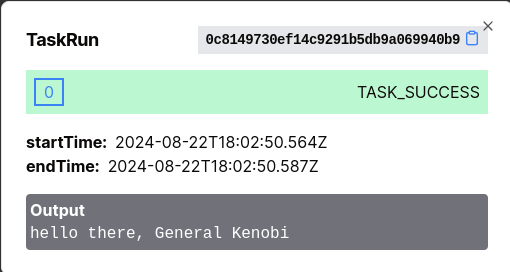Tasks
A WfSpec defines a series of steps in a process to be orchestrated by LittleHorse (in technical terms, each step is a Node). The most common type of step to execute is a TaskNode.

Task Structure
A unit of work executed by a computer in LittleHorse is represented by the dual objects TaskDef and TaskRun. A TaskDef is a LittleHorse API Object which defines a certain type of task that can be executed by a computer. A TaskRun is a LittleHorse API Object representing an instance of such a task being executed by a computer as part of a WfRun.
Executing Tasks
A Task Worker is a program written by a LittleHorse user that connects to the LH Server, polls for ScheduledTasks to execute, executes the Tasks, and returns the result to LittleHorse. Task Workers can be easily developed using the Task Worker SDK's in Java, GoLang, and Python according to our documentation here.
When a ThreadRun arrives at a TaskNode, the LittleHorse Server puts a ScheduledTask on a virtual Task Queue. The ThreadRun blocks at that NodeRun until a Task Worker pulls the ScheduledTask off the Task Queue, executes it, and reports the result (or if the configured timeout expires).
Once the TaskRun is completed, the output from the Task Worker's method invocation can be used by the workflow to mutate variables and control the flow of execution.
Task Workers open a web connection to the LittleHorse Server and do not need to receive connections on any ports. This has several benefits:
- Added security, since your systems do not need to accept any incoming connections.
- Built-in throttling, since the LittleHorse Server only dispatches a
ScheduledTaskto a Task Worker once the worker notifies the LH Server that it has capacity to perform a task. - Performance, since the protocol is based on grpc bi-directional streaming.
Task Logic
The work performed by Task Workers can be incredibly diverse, ranging from charging a customer's credit card to fetching data from an API to deploying infrastructure (as in a devops pipeline). Our Java, Go, and Python SDK's provide utilities that allow you to easily convert a function or method into a Task Worker in five lines of code or less.
In short, a Task Worker can perform any arbitrary function in code. However, we recommend using Task Workers for processes that take on the order of seconds rather than minutes or hours. For longer-running tasks, we recommend using a TaskRun to kick the process off and an ExternalEvent to note its completion.
Deploying a Task Worker
A Task Worker is any program that uses the Task Worker SDK's to execute TaskRun's. LittleHorse is not opinionated about where or how the Task Worker is deployed: it can be a JVM process running on a bare metal server under a desk; it can be a docker container on ECS, or a Pod in Kubernetes.
Additionally, a single process can run multiple Task Workers for different TaskDef's at once. This is often useful if you want to take advantage of workflow-driven processes but you have no need for microservices and as such want to avoid managing multiple deployable artifacts.
TaskRun LifeCycle
When a TaskRun is created, the LH Server first assigns the input_variables for that TaskRun. The input_variables of the TaskRun must match up in terms of name and type with the input_vars of the associated TaskDef. This mirrors how the arguments to a function invocation in programming must match the method signature.
For a TASK NodeRun, the output of the NodeRun (for use with Variable mutations) is determined by the output of the first successful TaskAttempt.
TaskRun Status
A TaskRun can be in any of the following statuses:
TASK_SCHEDULED: It has been scheduled but a Task Worker has not yetTASK_RUNNING: A Task Worker has received the Task but not yet reported the result.TASK_SUCCESS: TheTaskRunwas completed 🙂TASK_FAILED: An unexpected error or exception was encountered.TASK_TIMEOUT: The Task Worker did not report a result for theTaskRunwithin the allotted timeout.TASK_OUTPUT_SERIALIZING_ERROR: The Task Worker executed theTaskRunbut was unable to serialize the result when reporting back to the LH Server.TASK_INPUT_VAR_SUB_ERROR: The LH Server was unable to calculate the input variables for theTaskRun, or the Task Worker was unable to deserialize them and call the actual function.
Retries and TaskAttempt
A TaskRun has a max_attempts field which is used to determine the number of retries for a TaskRun. This is determined by the TaskNode structure.
Multiple different Nodes and even different WfSpecs can use the same TaskDef. Since retries are configured at the TaskNode level, it is possible for two TaskRuns of the same TaskDef to have a different maximum number of retries.
When a TaskRun is first created, a TaskAttempt is also created. If the TaskAttempt comes back with a TASK_SUCCESS status, then great! The TaskRun is completed, and if it is associated with a TASK NodeRun, then the output of the NodeRun is just the output of the TaskAttempt.
A TaskAttempt is considered retryable if it ends with the following states:
TASK_FAILED, denoting an exception.TASK_TIMEOUT, denoting that the Task Worker did not report the result of theTaskAttemptin time.
If a TaskAttempt is retryable and there are sufficient retries left, then another TaskAttempt within the same TaskRun is created. If any of the retry TaskAttempts succeed, then the output of the TASK NodeRun is the output of the first successful TaskAttempt. If all fail, then NodeRun fails.
Interruptibility
A TaskRun is considered interruptible if its current TaskAttempt is interruptible. A TaskAttempt is interruptible if it is in any of the following statuses:
TASK_SUCCESSTASK_FAILEDTASK_TIMEOUTTASK_OUTPUT_SERIALIZING_ERRORTASK_INPUT_VAR_SUB_ERROR.
A TaskAttempt in the TASK_SCHEDULED or TASK_RUNNING state is not considered interruptible; the associated ThreadRun will remain in the HALTING state until the TaskAttempt is reported (either success or failure) or is timed out.
For more information, see the ThreadRun Lifecycle documentation.